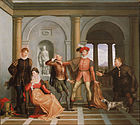 Washington Allston (November 5, 1779 – July 9, 1843) was an American painter and poet, born in Waccamaw Parish, South Carolina.
Allston pioneered America's Romantic movement of landscape painting. He
was well known during his lifetime for his experiments with dramatic
subject matter and his bold use of light and atmospheric color.
Washington Allston (November 5, 1779 – July 9, 1843) was an American painter and poet, born in Waccamaw Parish, South Carolina.
Allston pioneered America's Romantic movement of landscape painting. He
was well known during his lifetime for his experiments with dramatic
subject matter and his bold use of light and atmospheric color.Allston was sometimes called the "American Titian" because his style resembled the great Venetian Renaissance artists in their display of dramatic color contrasts. His work greatly influenced the development of U.S. landscape painting. Also, the themes of many of his paintings were drawn from literature, especially Biblical stories.
His artistic genius was much admired by Samuel Taylor Coleridge, and Ralph Waldo Emerson was strongly influenced by his paintings and poems, but so were both Margaret Fuller and Sophia Peabody, wife of Nathaniel Hawthorne.
The influential critic and editor Rufus Wilmot Griswold dedicated his famous anthology The Poets and Poetry of America to Allston in 1842. Poet Henry Wadsworth Longfellow, 17 years after Allston's death, wrote that: "One man may sweeten a whole time. I never pass through Cambridge Port without thinking of Allston. His memory is the quince in the drawer and perfumes the atmosphere."
Boston painter William Morris Hunt was an admirer of Allston's work, and in 1866 founded the Allston Club in Boston, and in his arts classes passed on to his students his knowledge of Allston's techniques.
Washington Allston was the first to use (apparently) the term Objective Correlative in 1840 which subsequently revived and made famous by T.S Eliot in essay on Hamlet (1919). The term denotes a set of objects, a situation, a chain of events which shall be the formula of that particular emotion;such that when the external facts, which must terminate in sensory experience, are given, the emotion is immediately evoked.
The west Boston, Massachusetts neighborhood of Allston is named after him.
Washington Allston select paintings:





